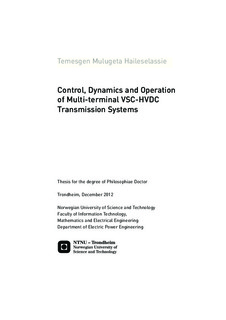| dc.contributor.author | Haileselassie, Temesgen Mulugeta | nb_NO |
| dc.date.accessioned | 2014-12-19T13:53:40Z | |
| dc.date.available | 2014-12-19T13:53:40Z | |
| dc.date.created | 2013-01-16 | nb_NO |
| dc.date.issued | 2012 | nb_NO |
| dc.identifier | 589072 | nb_NO |
| dc.identifier.isbn | 978-82-471-4036-9 (printed ver.) | nb_NO |
| dc.identifier.isbn | 978-82-471-4037-6 (electronic ver.) | nb_NO |
| dc.identifier.uri | http://hdl.handle.net/11250/257409 | |
| dc.description.abstract | In recent years, there has been an increased development and deployment of renewable energy resources to meet the ever increasing electric power demand and to limit the use of fossil fuels. This has spurred offshore wind farm development, particularly in the North Sea, due to the vast offshore wind energy potential. Large scale wind farms in the North Sea pose grid integration challenges such as the need for long distance sub sea power transmission and managing the variability of wind power variation on in the power grid. These challenges can be properly met by the use of multi-terminal voltage source converter high voltage dc transmission (MTDC) grid. Even though the North Sea region is envisioned as the immediate target of application, MTDC can also be used as the highway of power in onshore systems, thereby connecting loads and generation sites involving very long distances.
MTDC system consists of three or more HVDC converter stations connected to a common dc transmission network. Currently there are two types of converters used in HVDC, namely: line commutated converter (LCC) type and voltage source converter (VSC) type. VSC-HVDC is superior to LCC-HVDC for MTDC applications due to its flexibility and relative simplicity in power control, its bi-directional power transmission capability while keeping the dc voltage polarity unchanged and due to its reactive power support capabilities. Hence most recent research works in the area of MTDC have focused on VSC based systems only. Several R&D works have been done in the area of MTDC transmission, especially in its control aspects, in the past. In most cases however, only qualitative approaches have been used to describe the operational characteristics of the various proposed control strategies. In particular, studies exploring the quantitative analysis of the steady-state and dynamic operational characteristics of MTDC grids have been missing in the literature.
The research work described in this thesis was started with the objective of filling some of these gaps, i.e. (1) to investigate the various control strategies of VSC for use in dc grids using both qualitative and quantitative approaches, (2) to propose improvements in the control and operation of MTDC systems and (3) to increase understanding of the dynamic behavior of MTDC systems.
The main contributions of the research work can be put into three areas, namely MTDC control, MTDC operation and MTDC analysis. In the area of MTDC control grid frequency support strategy by MTDC has been proposed and analyzed. The control strategy enables exchange of primary reserves between asynchronous ac grids connected by MTDC without involving the use of communication systems between converter stations.
In the area of MTDC operation a method for precise control of steady-state power flow in MTDC has been proposed and tested with simulation models. The method enables power injection control in MTDC based on the power dispatch and is applicable to any MTDC transmission topology.
The contributions in the area of MTDC analysis comprise of three parts, namely: (1) steady-state MTDC interaction, (2) state-space modeling of a generalized MTDC topology and (3) large-disturbance stability analysis of MTDC. Methods have been proposed for each of the aforementioned MTDC analysis aspects and tested with various simulation models. In the integrated ac/dc system events, such as load insertion/ rejection in the ac grid will have impacts on grid frequencies as well as dc-bus voltages in the MTDC. The steady-state interaction analysis is used to estimate the steady-state changes (of frequencies, dc-bus voltages, transfered nodal powers) that come as a result of such events. The state-space modeling approach has been used to study the dynamic aspect of MTDC. The large-disturbance stability analysis has been principally proposed to study the impact of ac short circuit fault close to a converter terminal in rectifier mode of operation. Ac faults occurring close to inverters connected to MTDC transmission result in excess power in the MTDC during the fault duration. This however can be tackled by using fast acting dc voltage controllers and hence excess power in the dc grid may not as sever problem as shortage of power.
In addition, secondary control of MTDC based upon steady-state sensitivity analysis has been proposed in the thesis. The method enables accurate compensation of power flow deviations in MTDC occurring due to the action of primary control. Various representative case models have been used to show the merits claimed for each of the proposed control methods, and to verify the validities of the proposed operational strategies and MTDC analysis approaches. Finally a hypothetical dc grid scenario has been used to demonstrate the various potential benefits of employing MTDC in the North Sea region. | nb_NO |
| dc.language | eng | nb_NO |
| dc.publisher | Norges teknisk-naturvitenskapelige universitet, Fakultet for informasjonsteknologi, matematikk og elektroteknikk, Institutt for elkraftteknikk | nb_NO |
| dc.relation.ispartofseries | Doktoravhandlinger ved NTNU, 1503-8181; 2012:354 | nb_NO |
| dc.title | Control, Dynamics and Operation of Multi-terminal VSC-HVDC Transmission Systems | nb_NO |
| dc.type | Doctoral thesis | nb_NO |
| dc.contributor.department | Norges teknisk-naturvitenskapelige universitet, Fakultet for informasjonsteknologi, matematikk og elektroteknikk, Institutt for elkraftteknikk | nb_NO |
| dc.description.degree | PhD i elkraftteknikk | nb_NO |
| dc.description.degree | PhD in Electric Power Engineering | en_GB |
